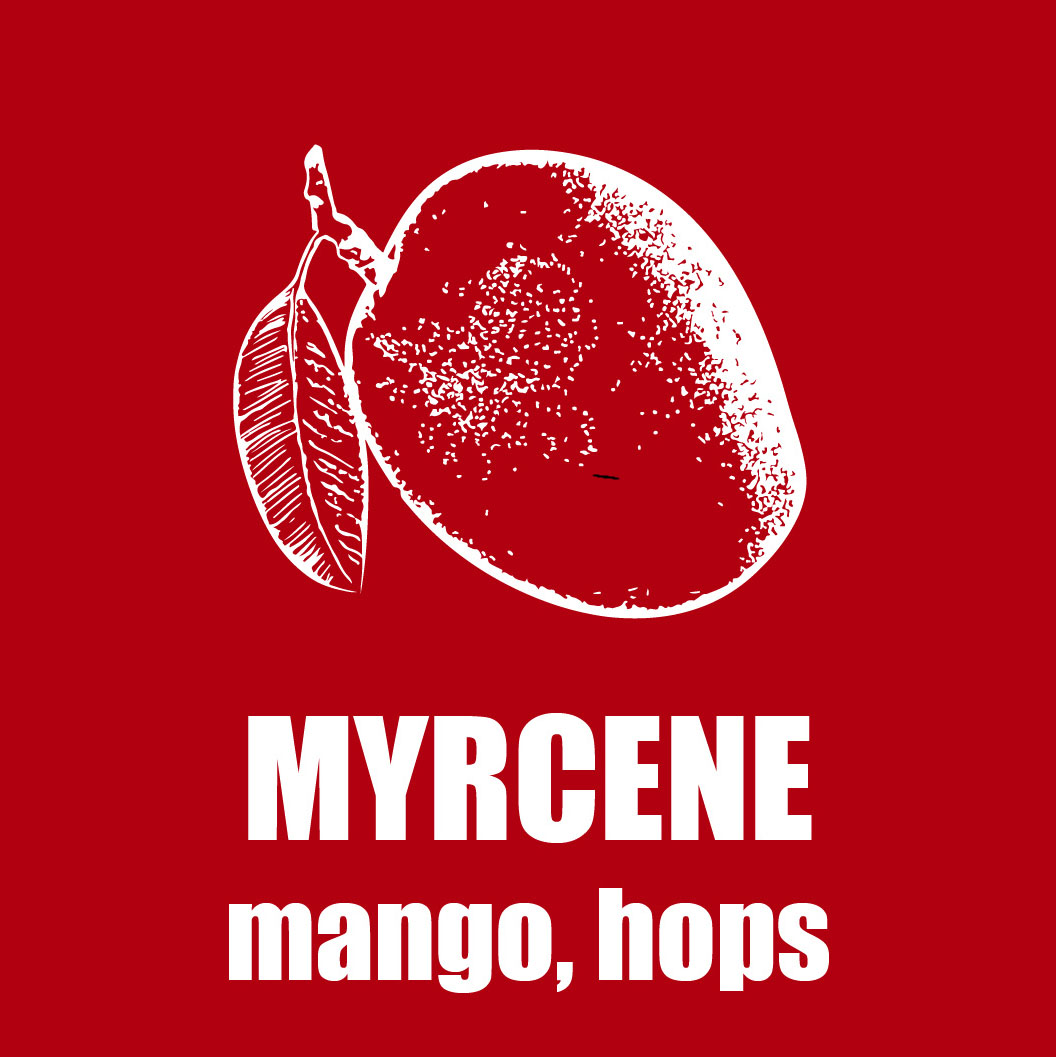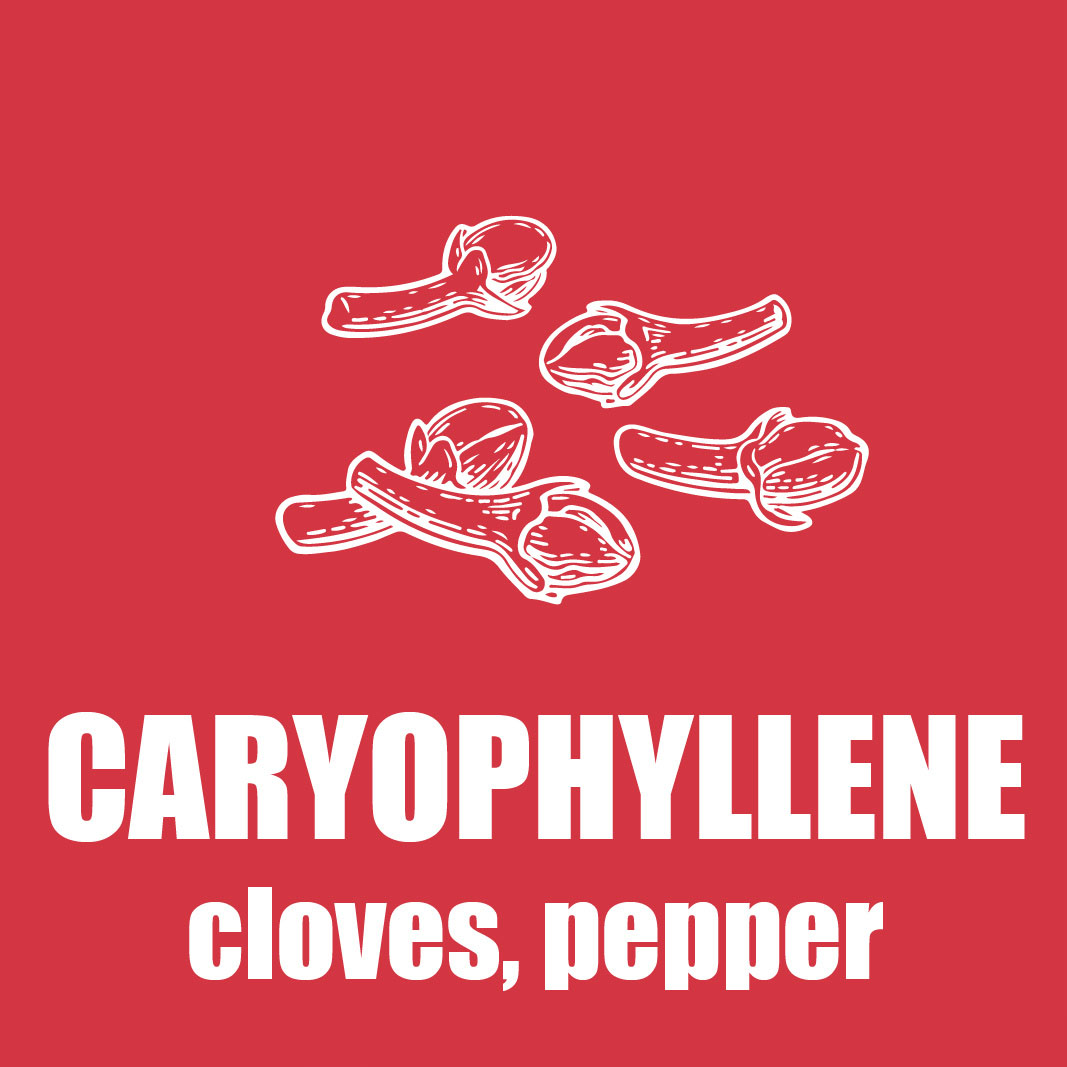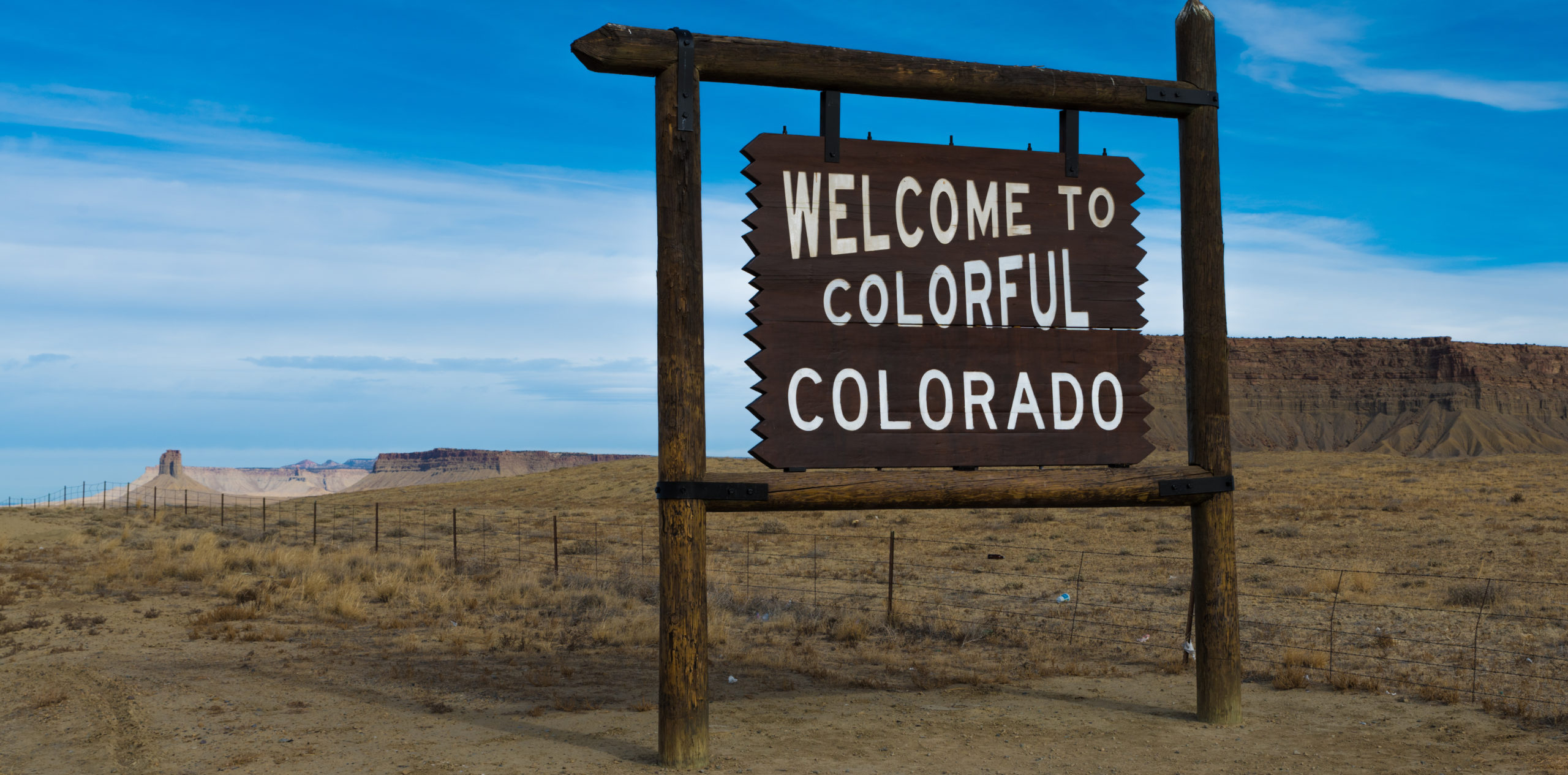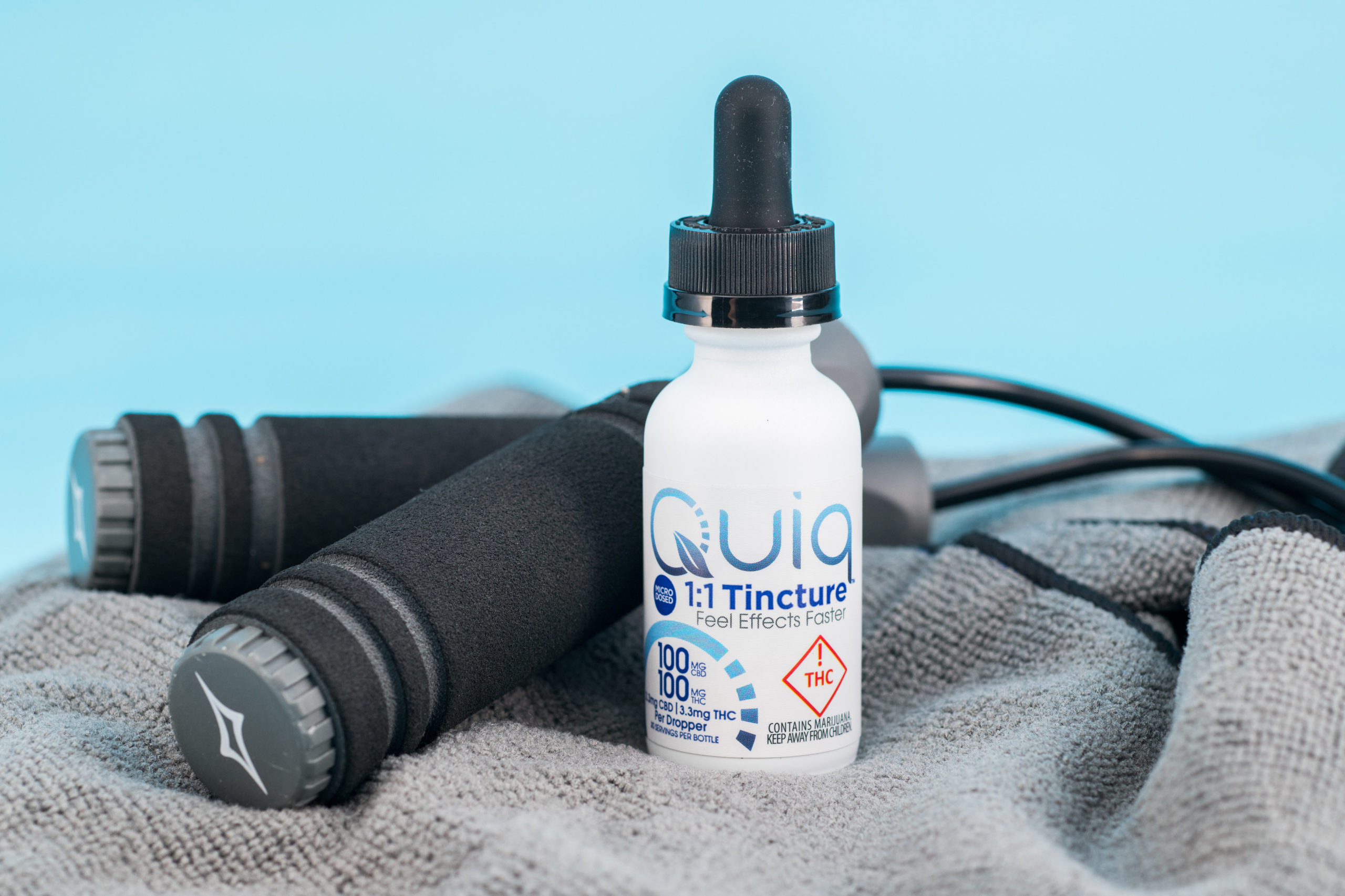What Are Terpenes and Why Should You Care?
The distinct aroma of cannabis – some love it, some don’t – but either way, what creates this unique fragrance is something quite complex and powerful – terpenes. What are terpenes? And why should you care? Knowing what they are and what they do will give you a new appreciation of this sacred plant, so let’s dive in!
Think of terpenes as essential oils, the aromatic compounds that give blueberries their blueberry taste and lavender its lavender smell. Although they are under researched at this time, they are among the fastest growing areas of interest in cannabis due to their potential influences on cannabis experiences and their many potential medical benefits. We do know that some terpenes may be pain relieving, sedating, energizing, anti-inflammatory, or antiviral (and the list goes on). Terpenes play an important role in the effects of CBD and THC through the entourage effect, which we will come back to a bit later. Here’s an easy way to wrap your head around how they work together – cannabinoids, such as THC and CBD, are like the engine of a car, and terpenes are like the steering wheel.
There are around 120 different cannabis terpenoids that have been identified so far, and when you learn what the terpene profiles are in various cannabis strains, you can start choosing strains based on how you’d like to feel.
Common Terpenes
Here are a few of the most common terpenes you’ll find in your favorite cannabis strains and what science has revealed about their primary potential therapeutic benefit.
- Myrcene = Relaxing. Myrcene smells like cloves and herbs. It is the most common terpene in cannabis, and you can find high levels of it in strains like OG Kush, Blue Dream and Grape Ape. Also found in lemongrass, thyme and mango.
- Limonene = Energizing. Limonene smells like citrus, and inhalation of limonene increases serotonin and dopamine levels in key regions of the brain that are associated with anxiety, depression and stress. Look to strains such as Super Lemon Haze, Banana OG and Wedding Cake for high levels of limonene. Also found in citrus fruits, peppermint and eucalyptus.
- Beta Caryophyllene = Pain relieving, anti-inflammatory. Beta Caryophyllene acts as a cannabinoid, activating CB2 receptors of the endocannabinoid system. It has a woody and spicy smell. High levels are found Death Star, Bubba Kush and Sour Diesel. Also found in hops, cloves, rosemary and black pepper.
- Pinene = Soothing, comforting. Pinene smells like pine and is great for opening bronchial passages. You’ll find high levels in strains such as Purple Kush, Snoop’s Dream and Critical Mass. Also found in pine needles, basil, parsley, and dill.
Terpenes & the Entourage Effect
The term entourage effect was created by professors, S. Ben Shabat and Raphael Mechoulam, to represent biological synergy of cannabinoids and other compounds, such as terpenes. A central understanding of the use of botanical remedies is that herbs contain many active ingredients. Primary active ingredients may be enhanced by secondary compounds, which act in beneficial synergy. Other herbal constituents may mitigate the side effects of dominant active ingredients.
Terpenes interact with our endocannabinoid system and assist cannabinoids in entering the bloodstream through the entourage effect. Ethan Russo, a leading medical cannabis doctor and researcher, says that cannabinoids and terpenoids are half-siblings and that terpenes are critical components to the medicinal effects of cannabis. He also found evidence showing that terpenes can enhance the beneficial effects of THC and reduce its adverse effects.
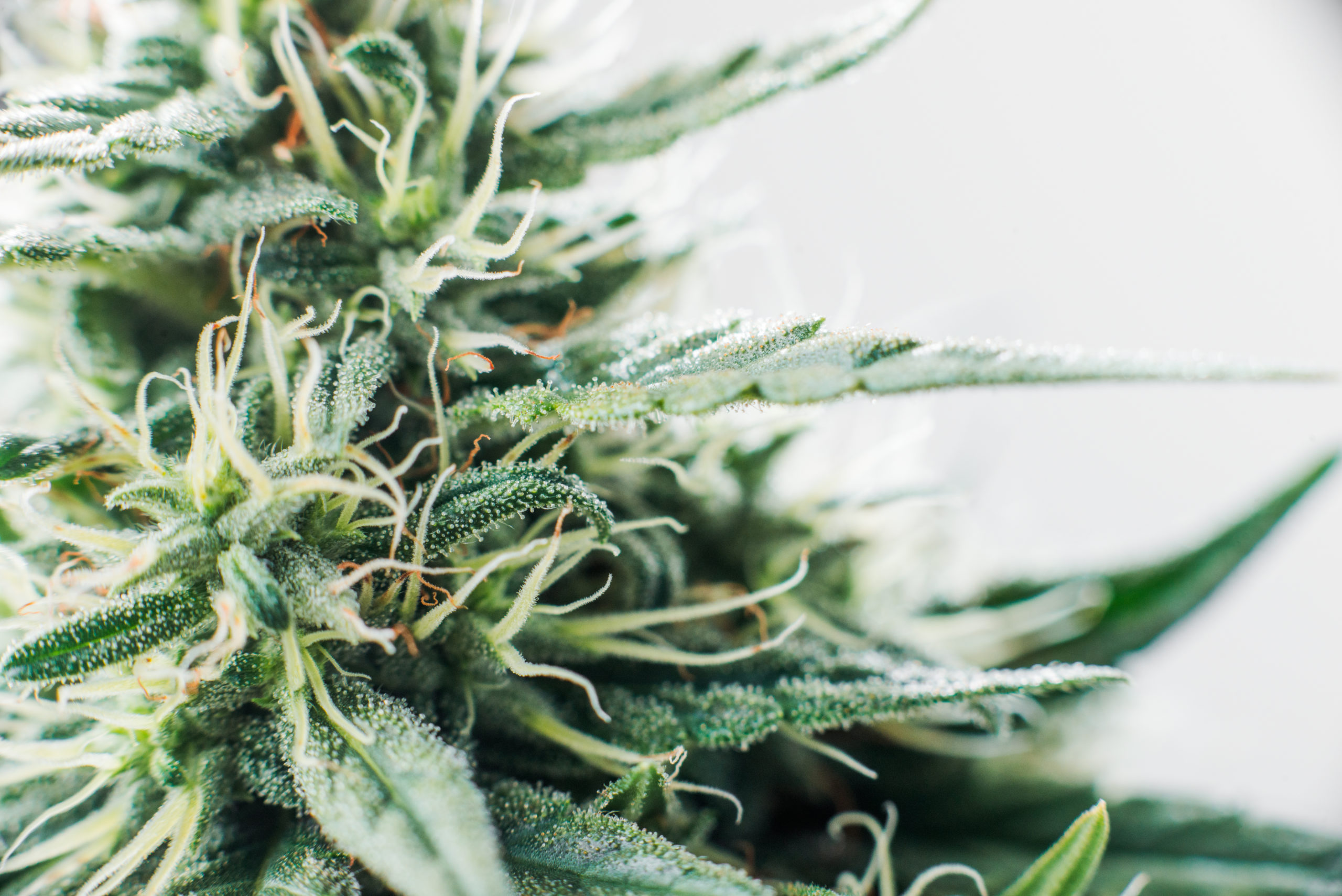
How Consumption Methods Affect the Effects of Terpenes
The effects and benefits of terpenes can vary based on the consumption method utilized. With inhalation of flower or extracts, many of the fragile terpenes are lost due to the high heat of direct fire, especially via smoking. Vaporization, on the other hand, allows for greater temperature control and can reduce the number of terpenes lost, giving this inhalation method greater access to their therapeutic benefits and a fuller flavor profile.
With oral consumption of edibles, much more research is needed to fully understand the effects. What has been revealed so far are various beneficial digestive effects. For example, myrcene has been found to reduce the formation of ulcers in the stomach and small intestines, linalool has shown to protect the liver from damage, and limonene has shown to have similar benefits to myrcene and as an edible digests, may also increase the absorption of the cannabis compounds through the stomach and intestines.
Now that you know about terpenes, you are more likely to understand why you should indeed care. It’s important to note that since everyone is different, you may have an entirely opposite experience from a terpene or terpene profile than that of another person. Experiment with caution and keep notes with which terpenes you consume along with pertinent dosing information, so you can use your own data to guide your future purchasing decisions.
A Guide to Cannabis Tourism in Colorado
The cannabis industry has much in store for you here in the land of the good ‘ole Rocky Mountains. With sales hitting nearly $1.75 billion in 2019 alone, Colorado is home to the nation’s longest-established recreational cannabis industry – and it aims to please. As the first state to legalize, Colorado is a destination for cannabis tourism.
If you’re new to cannabis and preparing to visit your very first pot shop or perhaps on a road trip to check out Colorado legalized recreational scene, it can feel overwhelming given all the options of where to shop, how to shop, what to buy, and where you can/can’t consume. But have no fear, we’ve put together a helpful guide for you to navigate with ease.
How to Find a Dispensary & Your Perfect Cannabis Product
Two websites you’ll want to bookmark are Weedmaps.com and Leafly.com – these are the best store and product locators, plus they offer a plethora of information on all things cannabis such as strain information, news, and deals. If you plan to navigate around on your own, they will be your best friends!
Unless you have a medical marijuana card, you’ll want to stay clear of anything labeled MEDICAL or MED, and instead look only for options that are labeled RECREATIONAL or REC. Some stores like the famous Native Roots dispensaries have both MED and REC options and are labeled as such.

If you’d like some extra support, cannabis tours are where it’s at! My 420 Tours offers guided tours of shops and even grow operations, where you can have an insider look at how cannabis is grown. Need help finding 420-friendly accommodations or transportation? They can help with that too. While you’re at it, check out some other fun cannabis tourism activities such as Puff, Pass, and Paint or Kush & Canvases to socialize with other cannabis lovers while bringing out your artistic side. (Note: COVID-19 may have affected some operations)
The primary categories of cannabis products are edibles, flower, vape, concentrates, and topicals. There are plenty of options within each of these categories, so it’s helpful to get clear on what product categories you’re most interested in:
• Looking for some energy and knee pain relief while trekking up a 14er? Edibles formulated with caffeine and/or energizing herbs are a great option, as well as topicals for acute pain relief.
• Are you looking to taste various flower strains? You can purchase high-quality bud from a gram up to as much as an ounce. Pre-rolls are joints ready to be smoked, which you can buy individually or in packs. Just know that the potency of flower these days is A LOT stronger than it used to be.
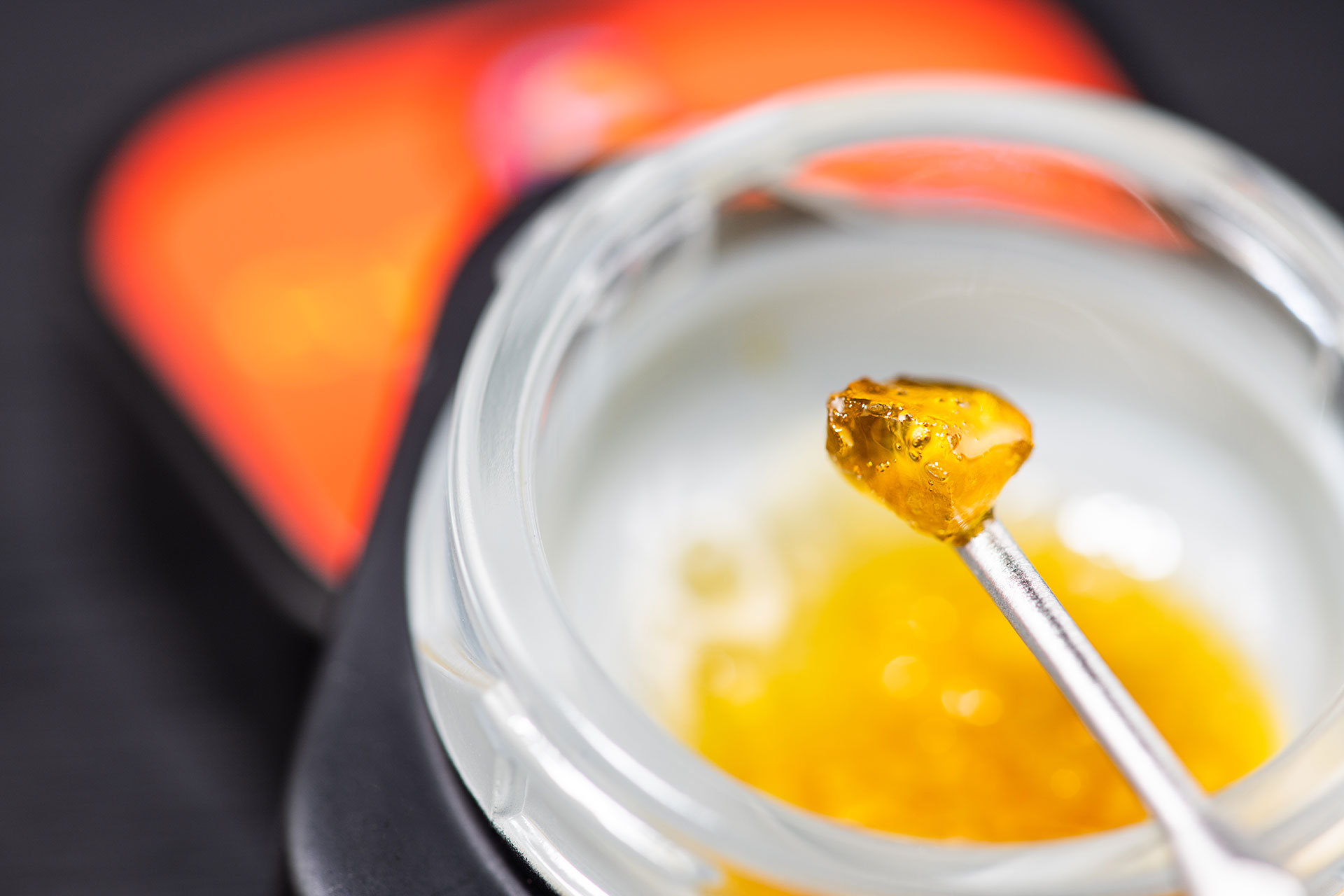
• Is a dabbing experience what you’re after? Concentrates will be your focus. This form of cannabis is the most potent available. You’ll need a dab rig or dab pen, and some stores carry these accessories for you to purchase.
• Perhaps you’re looking for something discreet and long-lasting to consume during a convention or a week-long seminar series? Edibles are an ideal choice. You can find all sorts of varieties from drinks to snacks, traditional onset to fast-acting, zero-calorie to full on sugar and fat…the sky’s the limit here!
What To Expect At a Dispensary
When you arrive to a dispensary, you’ll be greeted by either a security guard or front desk representative who will check your ID upon entry, so have it ready and keep it handy until you finish your purchase. (See this list of acceptable forms of ID). Be prepared to wait - there’s a limited number of people who can be inside the retail space at one time. If anyone in your party is under 21, they’ll have to remain outside the store. If you are part of a cannabis tourism group, they will give you details as well.
After checking in, you’ll be guided to shop one-on-one with a budtender to help you find the perfect products. Don’t be afraid to ask questions… that’s what they’re there for. If you’ve never consumed or haven’t consumed since high school, there are a lot of terms that will sound foreign to you, and budtenders are your best resource in the moment, so leverage their help! If you’ve done your research ahead of time, let them know what you’re looking for. If you have no idea what you want, be sure to tell
them how you’d like to feel, what your experience level is like, and ask for an overview of their offerings.
Most stores are cash-only, so bring cash or a debit card as most stores also have an ATM onsite. You can purchase up to one ounce of cannabis or equivalencies per day. The dispensary won’t record your name or divulge it to the government; however, staff are trained to watch for repeat customers who attempt to purchase more than the legal limit in one day.
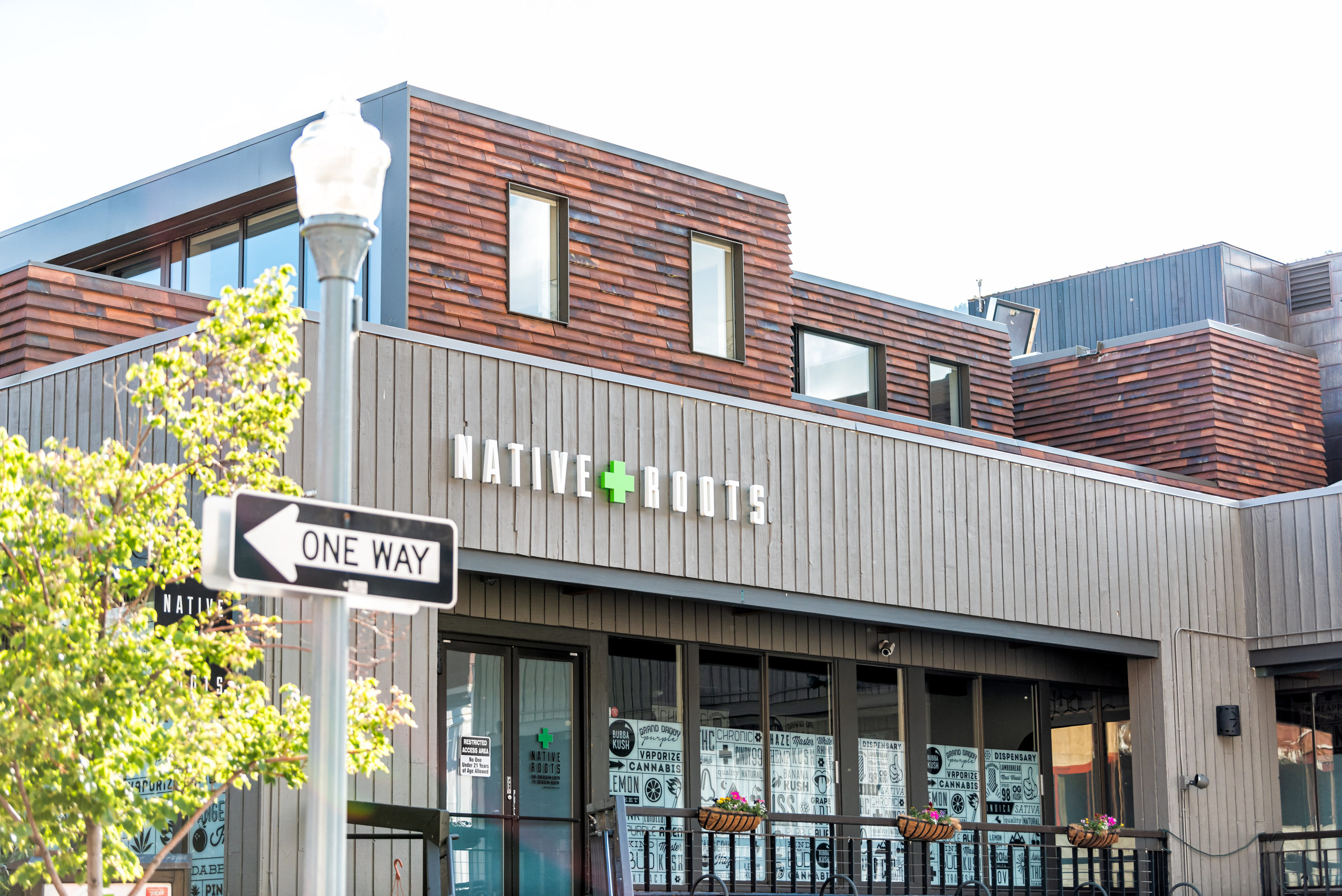
And know that it’s good etiquette to tip your budtender, especially if they spent a decent amount of time with you. Here’s some tipping insight for you to consider.
What You Need to Know About Legal Consumption
Just because you can walk into a store to buy weed doesn’t mean you can consume it anywhere. At this point in time, unfortunately, the restrictions on where you can and cannot legally smoke marijuana are vast. Smoking in public or in your car are big universal no-no’s! Your best bet is a private home, yet if
you don’t have that luxury there are some 420-friendly hotels and members-only cannabis clubs
throughout the state where you can pay for daily memberships.
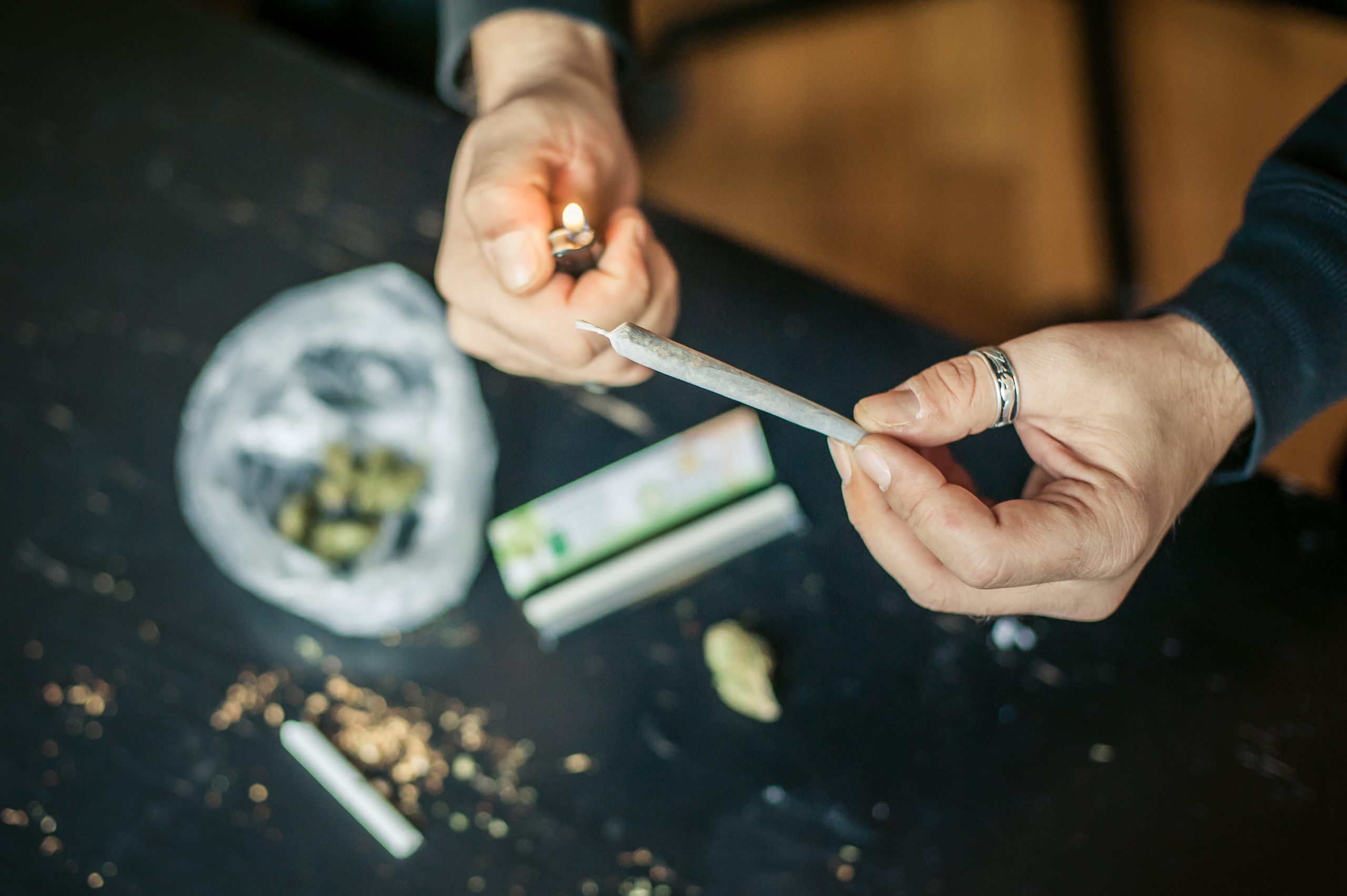
Each city has its own rules, so it’s helpful to know what to expect depending on where you’re aiming to go. For example, Colorado Springs is medical-only, so unless you have a medical card, you won’t be able to purchase from any pot shops in that town. There are also resources like cannabis tourism websites and activities to turn it into a full cannabis tourism experience. Resources like Westword can give you further information into popular destinations and further specificities on the laws.
And keep in mind, crossing state lines with your Colorado cannabis is illegal and can lead to an arrest if you’re pulled over, especially if you’re caught drugged driving. Due to the large number of people who visit Colorado intending to purchase cannabis to bring back home, cops are known to keep watch for cars exiting the state.
Wherever you choose to go and whatever you choose to consume, be smart, be safe, and go slow! You can always consume more, but you can’t consume less. Purchase cannabis products from a legal market, where industry leaders have set standards for third-party lab testing, encouraging consistency and safety.
The History of Cannabis Chocolate
From ancient prophetic brews to the cult-classic pot brownie, cannabis edibles in both food and drink form have been on a global journey through digestive systems everywhere over the last few thousand years. Let’s travel back in time through the present, taking a brief look at the history of cannabis chocolate so you can learn why cannabis edibles are now in such high demand.
Let’s start with the ancient Chinese emperor, Shen-Nun, who ruled around 2,700 BC and is known as the Father of Chinese Medicine. He documented various uses of cannabis medicinally. It seems the Chinese were the first in recorded history to ingest cannabis and introduce it as a medicine to the world. However, the earliest recorded cannabis edible was in the Indian subcontinent. It is here that the native people have prepared food and drink with bhang as early as 1,000 BC, for both spiritual and medicinal purposes. This is also where the world’s most sought-after Kush cannabis strains originated.
Fast-forward to the 1800s when people in the United States began making cannabis tinctures, candy, and other infused foods. These were all sold as commonly as toothpaste and even advertised in local newspapers. In more modern times, cannabis-infused food was credited to the publication of The Alice B. Toklas Cook Book in 1954. In it, she included a recipe for “hashish fudge”, a baked good based on an 11th century Moroccan sticky confection recipe, majoun. This sweet treat resembles a truffle. It contains aromatic spices along with cocoa powder, honey, butter, nuts, dried fruit, and of course, hash. Many say the pot brownie was born from this recipe. Now in 2021, many top chefs are even crafting their own edibles.
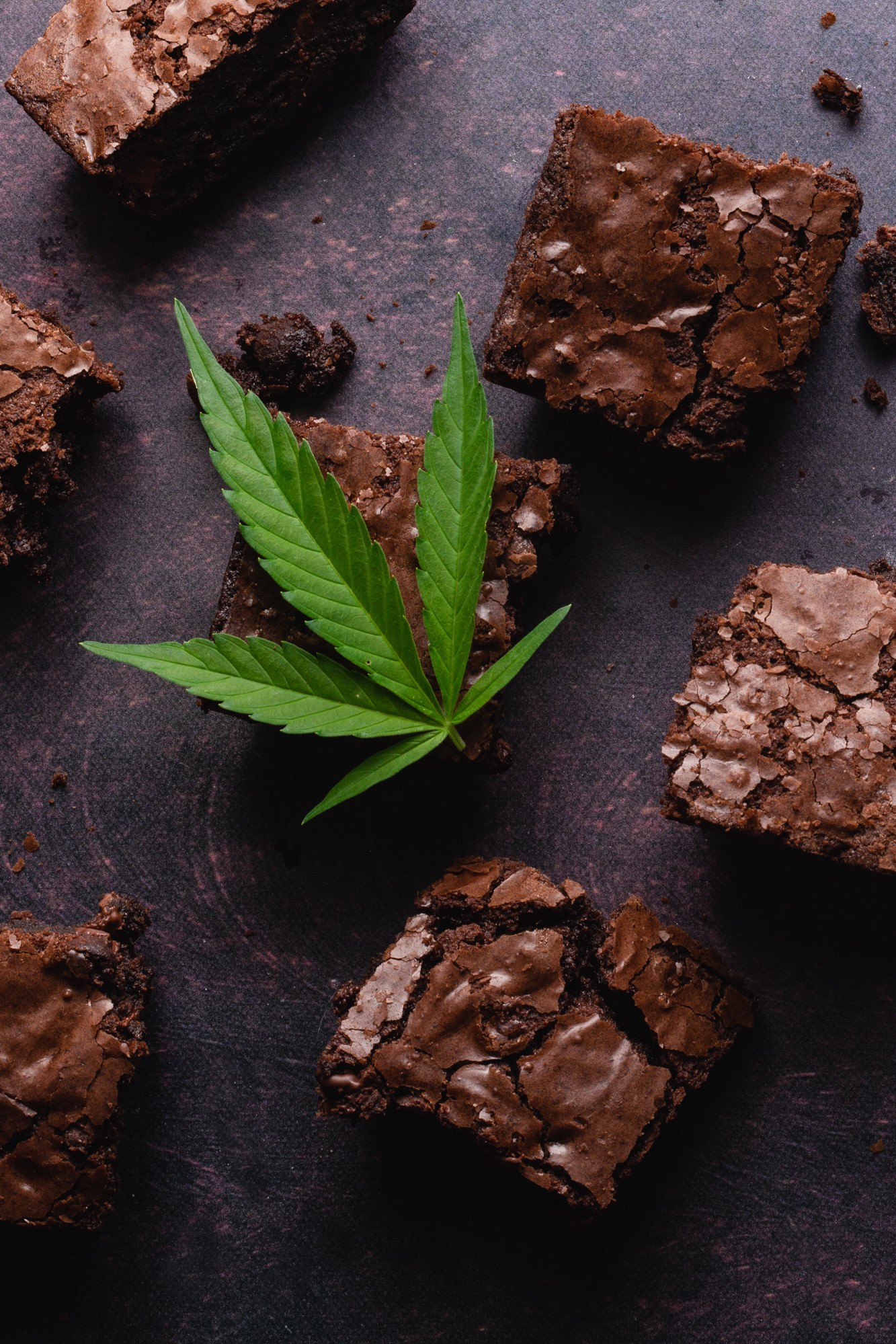
The Emergence of the Cannabis Industry
Everything began to change once the Pure Food and Drugs Act of 1906 went into effect. This laid the foundation for future cannabis prohibition. Over the course of the following three decades, cannabis became illegal to include in any formulations. The government was also able to start arresting people for cannabis offenses, which has unfortunately continued through to this present day.
The country slowly started coming back to its senses in the 1970s when some states began decriminalizing cannabis. In 1996, California led the way with medicinal legalization through the Compassionate Care Act. This movement was driven by the efforts of the legendary Denis Peron, who co-founded the first semi-legal dispensary in the United States and teamed up with the infamous Brownie Mary, a 69-year-old activist. Together they distributed cannabis edibles to patients in need of pain and nausea relief. Since then, the path of legalization has been far from easy.
The Early Days of Manufacturing Edibles
During this phase of development, industry regulations regarding cultivation and manufacturing practices did not exist. Picture this: Mrs. Smith procures cannabis extract from cannabis flower she grows herself. In her home kitchen, she bakes it into infused foods such as candies and brownies. She then sells them wholesale to her friend who has a dispensary, who sells them to their patients. All of this was done with no tracking systems in place. Edibles could be made in anyone's kitchen without lab tests; hence, dosing was highly inaccurate and inconsistent. Quality was questionable. As a customer, you’d just hope for the best.
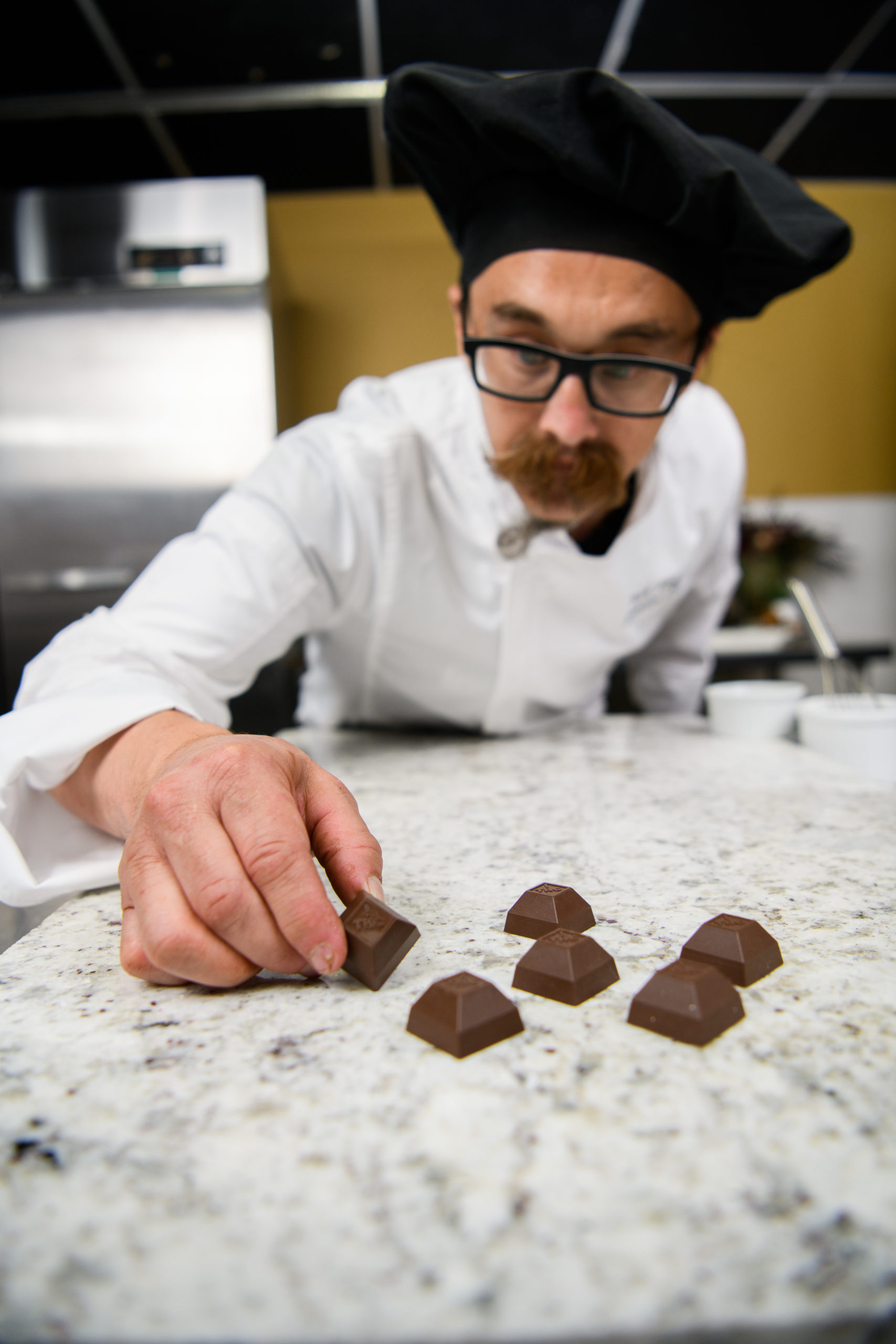
The Industry Puts on a “Suit and Tie” (without help from the government)
Still to this day, due to the federal regulation of cannabis as a Schedule 1 substance, the FDA does not regulate edibles. Individual states had to take it upon themselves to create a greater level of safety, consistency and quality. Industry innovators, such as Medically Correct, have led the way to craft safety regulations. States then adopted and enforced these regulations to protect the cannabis consumer and establish integrity in business practices.
As alluded to previously, consumers could get an edible with a descriptor as vague as “two-times the strength” one week. An edible from the same manufacturer with that same descriptor the next week could have a totally different effect. Before it even became mandated, Medically Correct committed to testing for activated milligrams of THC. They added this along with nutritional information on their product labels. This early focus on consistency and quality helped propel them to the top of the Colorado edibles market, which was the first in the nation to become a highly regulated market.
Why Chocolate Edibles Are In High Demand
As the variety of products available in the market began to rise, it became increasingly difficult for stores to carry chocolate-based baked goods due to their short shelf-life. This created a need for shelf-stable alternatives to items such as the cult-classic edible brownie. Enter the cannabis chocolate bar! This became an ideal solution for manufacturers, retail operations and consumers alike. Not only is it a familiar delight, it also allows for more precise dosing and longer shelf-life.
If you were to taste cannabis extract all by itself, you’d undoubtedly notice its pungent and bitter flavor. Chocolate, especially dark chocolate, has rich complex notes which are a perfect ingredient to mask these less than desirable flavors. Plus, when chocolate is infused with cannabis, the naturally occurring fat from the cocoa butter supplies the necessary lipids to help the body process it.
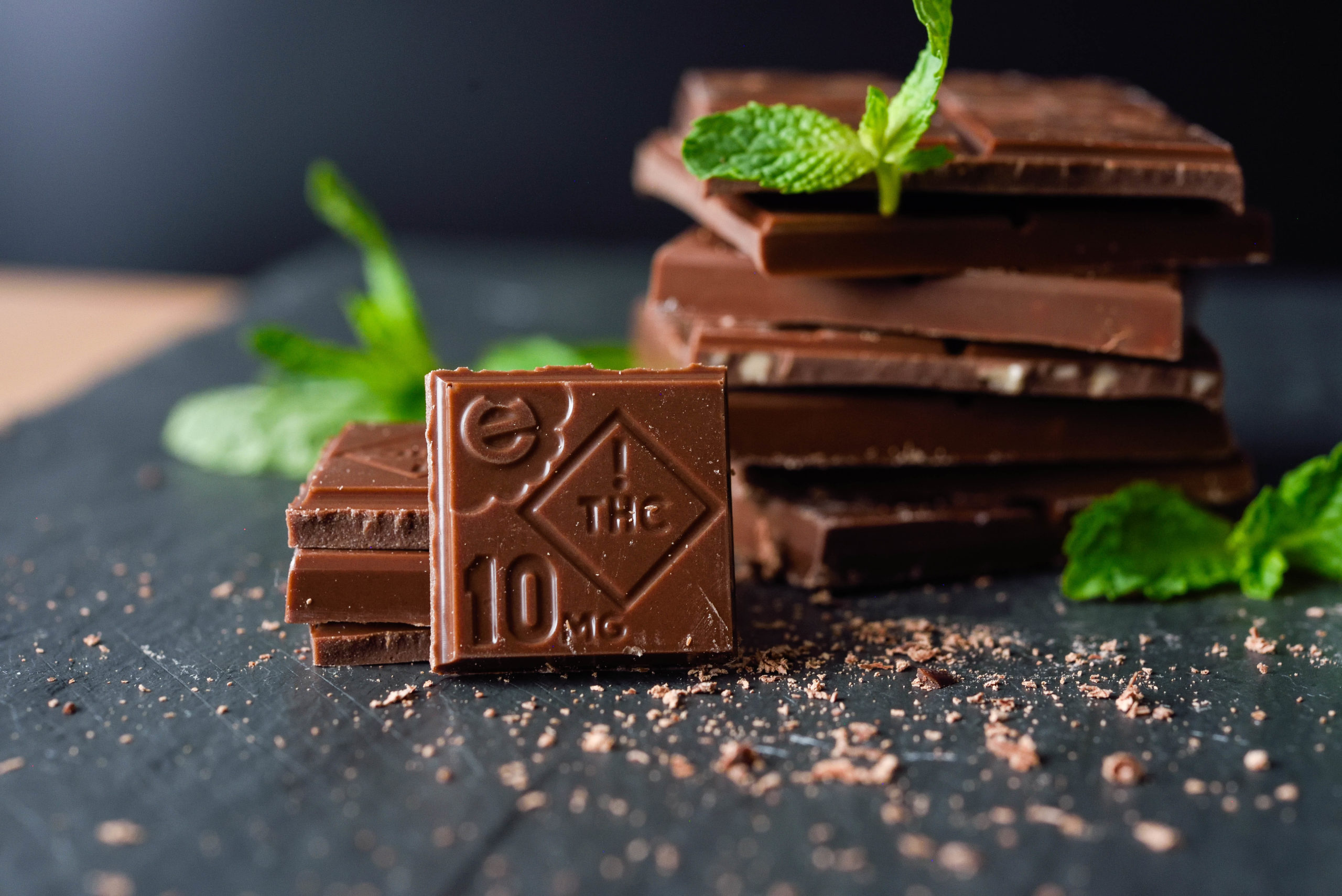
Combining cannabis with chocolate also has a chemically synergistic effect. In a nutshell, cacao beans produce a type of cannabinoid that the body itself also produces, called anandamide. It plays an important role in managing issues such as pain, mood, and appetite, and has similar effects to THC. Chocolate also contains theobromine, an alkaloid and caffeine-relative, and a known vasodilator that helps deliver nutrients and chemicals into the tissues. This creates an enhanced, elevated experience that lasts even longer.
__________________________________
Some trivia for you: Why does food taste so much better when you’re high? Well, cannabis is known to heighten sensory perception. This is due to THC binding with certain receptors in areas of your brain involved with your senses. Overall perceptions of yourself and your surroundings increase, including brighter colors, stronger smells, and richer tastes. YUM!
If you’re new to consuming cannabis edibles, check out this helpful guide to understand how eating cannabis is different than smoking it.
Be a savvy cannasseur and check out the delicious selection of Medically Correct’s cannabis-infused chocolates by visiting our Shop Now page.
Improve Athletic Recovery with Cannabis Edibles and Topicals
Cannabis becomes more mainstream every day as legalization has spread across the country. A multibillion-dollar industry sprang up almost overnight and has grown like … well, like a weed. One major sector of this industry is industrial hemp, quickly gaining popularity when the 2018 Farm Bill legalized the manufacture and sale of CBD-infused products nationwide. People unlikely ever to use cannabis have flocked to try the new array of wellness products, but still, the marijuana sector of the cannabis industry has greater demand. Innovative companies have come up with a wide variety of cannabis-infused products, mostly edibles and topicals, that target symptoms in creative ways. Athletes are one audience that brands often target, especially when it comes to improving athletic recovery with cannabis.

CBD and Athletic Recovery
CBD produces many of the same results as THC, but not that “high” feeling. Athletes tend to prefer it because they want to stay sharp during a workout.
But to say it has no psychoactive properties is not really true – CBD eases stress. It elevates one’s mood which can help team athletes respond positively to stress and anxiety, and to help solitary athletes push through mental blocks and physical plateaus. CBD produces bodily relaxation similar to a mild muscle relaxer, good for recovery and sore muscles.
Perhaps the compound’s most exciting action is its ability to fight excess fat and prevent obesity. In a 2016 study published in Molecular and Cellular Biochemistry, scientists discovered that “CBD encourages the metabolism of existing fat cells [and] prevents the formation of new fat cells.” The study states that more research is required, but the early findings are promising for the future of obesity prevention.
There are a variety of methods to consume CBD, and edibles are one of the most popular product categories. Great for extended workouts and endurance sports, edibles take about 30 minutes to an hour to kick in, and last several hours after that. Conveniently, you’ll likely experience their strongest effect at about the time you’ll be growing tired. Tinctures, on the other hand, are best used just before a workout because they take effect quickly; or use your CBD-infused oil for recovery and mix it into your post-workout protein shake.
CBD topicals are comparable to pain relief creams like Voltaren and Aspercreme, but are often made with more natural ingredients. You put the salve right where it hurts and the medicine will go straight through the skin to the source. Cannabis-infused bath salts are great for soaking after a workout, or right before bed to help you relax and get a good night’s sleep. This will help you heal, improving athletic recovery.
The Benefits of Using THC During Your Workout
While THC produces noticeable psychoactive effects, it offers a host of medical benefits, many of which may support athletic ability and recovery. THC is a vasodilator, which means it widens blood vessels and increases the flow of blood carrying oxygen throughout the body. It can lead to a better pump for weightlifters, and the fast-flowing blood carries more oxygen to the muscles before, during and after workout to keep them fresh, and help them heal.
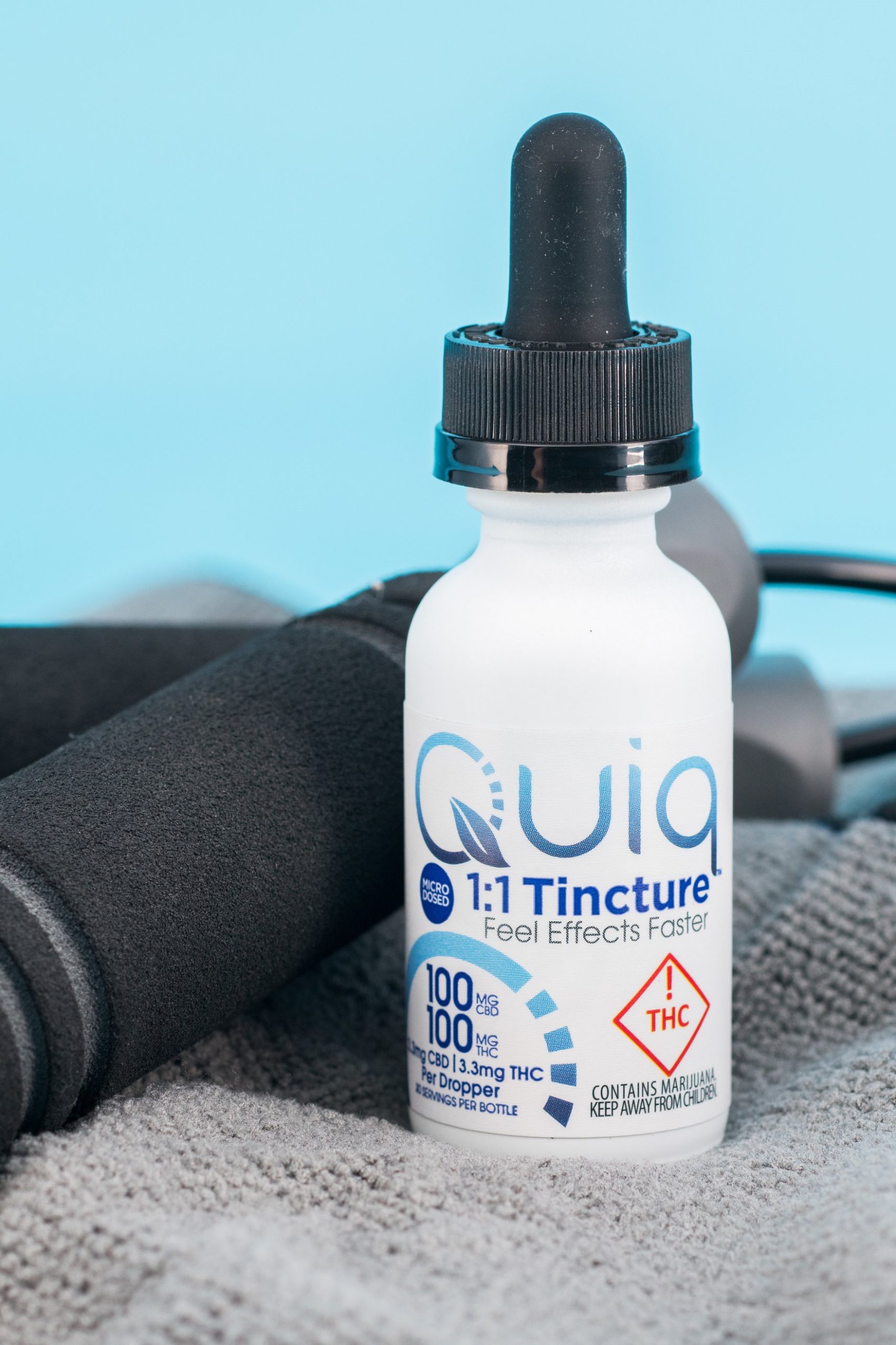
THC is also a bronchodilator, which expands airways, facilitating better, deeper breathing that brings more oxygen into the system, improves stamina and helps aerobic exercisers increase endurance.
THC’s anti-inflammatory properties relieve chronic pain from old injuries, arthritis, and lower back pain that plague weight lifters and older athletes. In higher doses, it encourages falling asleep and staying asleep. Rest is essential in order to recover faster.
Taken in the correct quantity, THC and the right terpenes can create focus, uplifted feelings and energy that will inspire you to get on your bike or pull on the running shoes and get down the road. Not only can cannabis help you get better results in the gym, it can give you the motivation to get up and go.
Don’t forget, THC makes you hungry. If you are serious about your health, get used to treating the munchies with leafy green vegetables, avocados, berries, and yogurt – which make a pretty good smoothie, by the way.
Athletes and Their Success with Cannabis
Wellness gurus and serious athletes have gravitated to cannabis products because they can relieve workout pain, bring on faster recovery, and help improve sleep quality. Could cannabis become an integral part of a healthy lifestyle?
One of the world’s best runners, who uses cannabis daily as part of his training, believes he is using the drug to implement his healthy lifestyle and keep him among the elite runners in the world. Cannabis edibles aid his athletic recovery. Avery Collins of Silverton, Colorado said that cannabis makes his runs more enjoyable. “They’re almost spiritual,” he added.
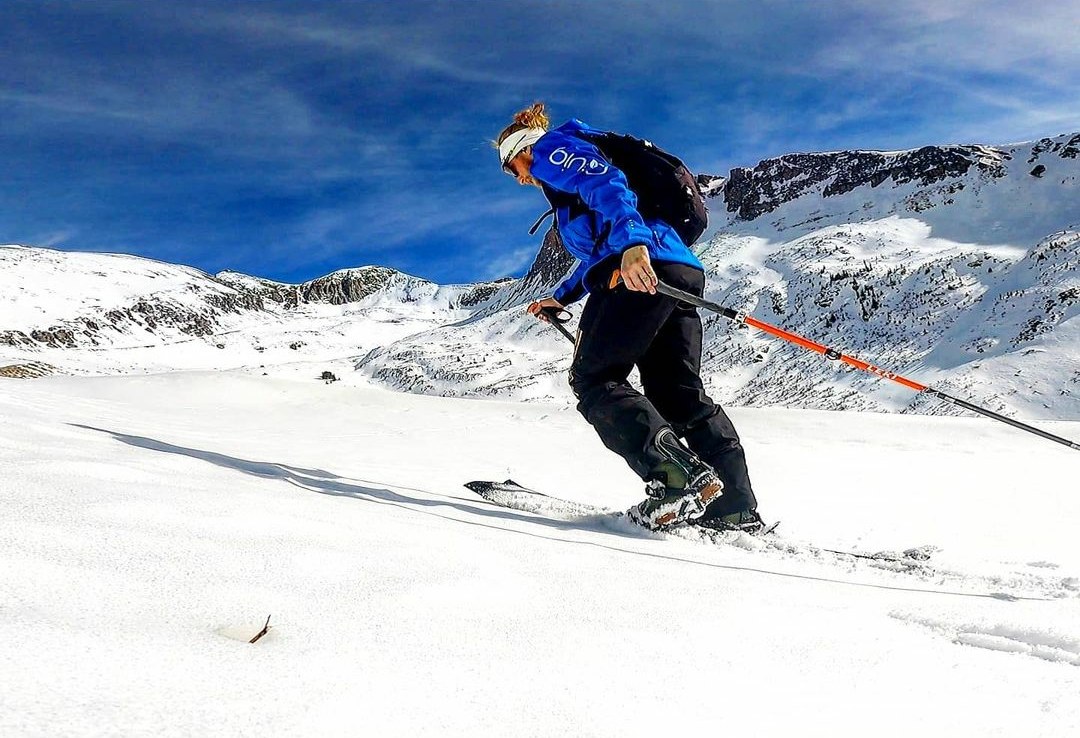
Avery believes in responsible consumption, and combines edibles, salves and an occasional smoke on his 140-mile a week training routine. He believes cannabis is a safe alternative to hard drugs and booze, and he also found it works with pain relief. Basically, he’s just a guy who loves weed and running, so he does both with abandon.
A trainer, doctor, and cannabis advocate has also found a niche in the use of CBD to help athletes get the most out of their bodies. Dr. Ben Cowin is a 20-year sports medicine veteran who treats professional athletes in his Denver practice and around the world. He said his research with CBD has changed the way he looks at treating athletes, and he’s even helped to formulate a hemp-infused topical for managing pain and inflammation.
“We can offer a safe alternative to pain control thanks to cannabinoids,” he said.
Get The Best Results When Using Cannabis for Athletic Recovery
Many findings indicate that when taken together, the benefits of CBD and THC can serve to intensify each other. If you live in a legalized state, try adding a small dose of THC to a larger dose of CBD. But if you play organized sports, make sure you aren't breaking any league rules by testing positive on a drug test. Also, if you are limited by the legality of marijuana in your state, know that CBD, in itself, can help to relieve pain, reduce inflammation, and improve sleep quality -- all important factors for athletic recovery.
When consuming cannabis products for performance and recovery purposes, be sure to pay attention to your body's response. Everyone is unique and no one size fits all. We advise keeping a journal and recording what applications and doses give you the best results. Be sure to purchase quality, lab-tested products and always remember to consume cannabis responsibly.


